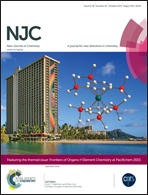Preparation and characterization of Cu–Co alloy nanoparticles from double complex salts by chemical reduction
Abstract
Magnetic Cu–Co alloy nanoparticles have been prepared by a chemical reduction method of double complex salts (DCSs). In this method Cu–Co alloy nanoparticles have been prepared from [Co(NH3)6]2[Cu(C2O4)2]3 (DCS1), [Co(NH3)5Cl][Cu(C2O4)2] (DCS2) and [Co(en)3]2[Cu(C2O4)2]3 (DCS3) coordination complexes. Reduction of these complexes occurred in ethanolic aqueous solution by hydrazine monohydrate. In order to characterize the synthesized compounds we have used XRD, EDX, SEM and IR spectroscopy. Magnetic properties and giant magnetoimpedance are investigated in Cu–Co nanoalloys. These alloys demonstrate ferromagnetic behavior, which is due to presence of Co in the alloys. This property makes them an excellent candidate for technological applications such as magnetic devices or sensors based on a magnetoimpedance effect. The relative phase abundances of Cu and Co were carried out with the GSAS software. The results of the Rietveld refinements show a good agreement between the observed pattern and the calculated values.


 Please wait while we load your content...
Please wait while we load your content...